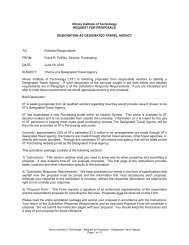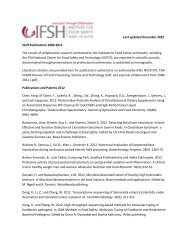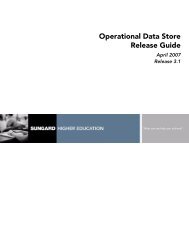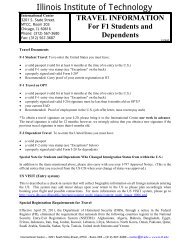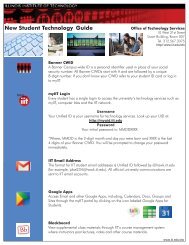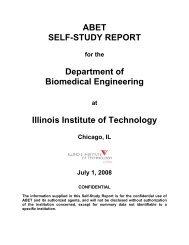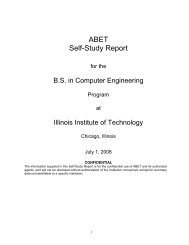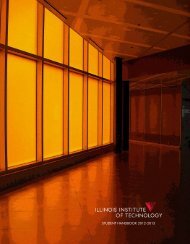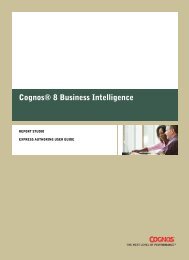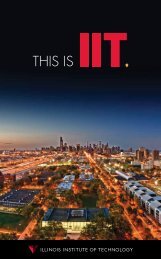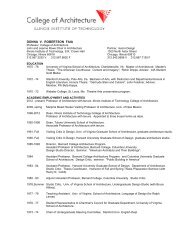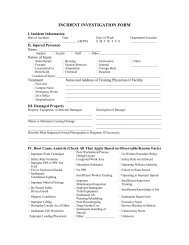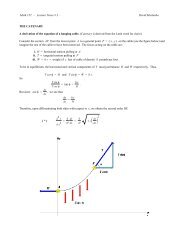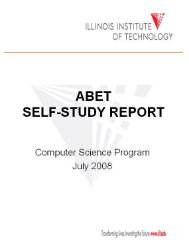Copyright & Disclaimer Information - Illinois Institute of Technology
Copyright & Disclaimer Information - Illinois Institute of Technology
Copyright & Disclaimer Information - Illinois Institute of Technology
You also want an ePaper? Increase the reach of your titles
YUMPU automatically turns print PDFs into web optimized ePapers that Google loves.
ITM 301<br />
Introduction to Contemporary Operating Systems<br />
and Hardware I<br />
Students study the basics <strong>of</strong> computer<br />
architecture and learn to use a<br />
contemporary operating system.<br />
Hardware requirements, micro-computer<br />
components, s<strong>of</strong>tware compatibility<br />
and system installation and<br />
options are covered, along with postinstallation<br />
topics, storage, security,<br />
and system diagnosis and repair.<br />
(2-2-3)<br />
ITM 302<br />
Introduction to Contemporary Operating Systems II<br />
Introduces features <strong>of</strong> an advanced<br />
operating system, including basic<br />
commands, file and directory manipulation,<br />
text editing and suitability<br />
for server applications. Basic programming<br />
in this environment will be<br />
addressed through shell scripting for<br />
job automation along with shell built-in<br />
data types, condition, loops, functions<br />
and regular expressions. (2-2-3)<br />
ITM 311<br />
Introduction to Object-<br />
Oriented Programming<br />
A broad introduction to object-oriented<br />
programming and the related<br />
knowledge necessary to program in a<br />
contemporary programming language.<br />
This would include coverage <strong>of</strong> an<br />
Application Development Kit, creating<br />
stand-alone applications and applets<br />
for enhancing Web pages. (2-2-3)<br />
ITM 312<br />
Introduction to Systems S<strong>of</strong>tware Programming<br />
Introduces basic concepts <strong>of</strong> systems<br />
programming. Students learn to<br />
apply basic programming concepts<br />
toward solving problems, create<br />
source files and header files, work<br />
with and effectively use basic data<br />
types, compile source code into binary<br />
executable files, and understand<br />
use <strong>of</strong> the “make” utility for project<br />
management. (2-2-3)<br />
ITM 411<br />
Intermediate Object-Oriented Programming<br />
Covers object oriented programming<br />
concepts using a Java application<br />
generator. Creating user interfaces,<br />
working with data, implementing<br />
security, and deploying the application<br />
are discussed in detail. Hands-on<br />
exercises reinforce concepts taught.<br />
Prerequisite: ITM 311. (2-2-3)<br />
<strong>Copyright</strong> & <strong>Disclaimer</strong> <strong>Information</strong>: <strong>Copyright</strong> © 1994, 1995, 1996, 1997, 1998, 1999, 2000, 2001, 2002, 2003, 2004, 2005, 2006, 2007. CollegeSource®, Inc. and Career Guidance Foundation. CollegeSource® digital catalogs are derivative works owned and copyrighted by CollegeSource®, Inc. and Career Guidance Foundation. Catalog content is owned and copyrighted by the appropriate school. While CollegeSource®, Inc. and Career Guidance Foundation provides information as a service to the public, copyright is retained on all digital catalogs.<br />
<strong>Copyright</strong> & <strong>Disclaimer</strong> <strong>Information</strong>: <strong>Copyright</strong> © 1994, 1995, 1996, 1997, 1998, 1999, 2000, 2001, 2002, 2003, 2004, 2005, 2006, 2007. CollegeSource®, Inc. and Career Guidance Foundation. CollegeSource® digital catalogs are derivative works owned and copyrighted by CollegeSource®, Inc. and Career Guidance Foundation. Catalog content is owned and copyrighted by the appropriate school. While CollegeSource®, Inc. and Career Guidance Foundation provides information as a service to the public, copyright is retained on all digital catalogs.<br />
ITM 412<br />
Advanced Structured and Systems Programming<br />
Structured programming continues<br />
with advanced concepts including<br />
strings, arrays, pointers, data structures,<br />
file manipulation, and dynamic<br />
memory management. Students<br />
create more complex applications<br />
that work with user input, manipulate<br />
user supplied text or text<br />
obtained from a file, apply standard<br />
library routines for working with literal<br />
text, use pointers to store complex<br />
structures within arrays, and<br />
read and write data from files, the<br />
console, and the terminal. The objectoriented<br />
programming (OOP) paradigm<br />
is covered in depth including<br />
the philosophy <strong>of</strong> OOP, classes and<br />
objects, inheritance, template classes,<br />
and making use <strong>of</strong> class libraries.<br />
Prerequisite: ITM 312. (2-2-3)<br />
ITM 414<br />
Visual Programming Environments<br />
Students will study the fundamental<br />
problems associated with manmachine<br />
interfaces. Students will<br />
learn to apply several GUI techniques<br />
to design, lay out and implement<br />
screen controls, menus and graphical<br />
objects using techniques such as logic<br />
flow and input validation. GUI programming<br />
elements <strong>of</strong> contemporary<br />
visual programming languages are<br />
introduced. Prerequisite: ITM 311 or<br />
ITM 312. (2-2-3)<br />
ITM 415<br />
Advanced Object-Oriented Programming<br />
Addresses advanced concepts in<br />
object-oriented programming. Handson<br />
exercises reinforce concepts<br />
taught. Using an integrated OO programming<br />
and HTML development<br />
environment, students will build a<br />
final Web project. Prerequisite: ITM<br />
411. (2-2-3)<br />
ITM 421<br />
Data Modeling and Applications<br />
Basic data modeling concepts are<br />
introduced. Hands-on database<br />
design, implementation, and administration<br />
<strong>of</strong> single-user and shared<br />
multi-user database applications<br />
using a contemporary relational<br />
database management system. (2-2-3)<br />
IIT Undergraduate Bulletin 2006–2008<br />
Course Descriptions<br />
ITM 422<br />
Advanced Database Management<br />
Advanced topics in database management<br />
and programming including<br />
client server application development<br />
are introduced. Expands knowledge<br />
<strong>of</strong> data modeling concepts and introduces<br />
object-oriented data modeling<br />
techniques. Students will learn how<br />
to design and develop Client/Server<br />
database applications for various<br />
business solutions, incorporating<br />
Client/Server application design.<br />
Business system planning, analysis,<br />
development and implementation are<br />
discussed. Students will learn how to<br />
design event-driven applications utilizing<br />
application management tools<br />
as well as use <strong>of</strong> graphical user interface<br />
design to create user-friendly<br />
applications. Prerequisite: ITM 421.<br />
(4-4-6) (C)<br />
ITM 428<br />
Database Security<br />
Students will engage in an in-depth<br />
examination <strong>of</strong> topics in data security<br />
including security considerations in<br />
applications & systems development,<br />
encryption methods, cryptography<br />
law and security architecture & models.<br />
Prerequisite: ITM 421. (3-0-3)<br />
ITM 440<br />
Introduction to Data Networks and the Internet<br />
This course covers current and evolving<br />
data network technologies, protocols,<br />
network components, and the<br />
networks that use them, focusing on<br />
the Internet and related LANs. The<br />
state <strong>of</strong> worldwide networking and<br />
its evolution will be discussed. This<br />
course covers the Internet architecture,<br />
organization, and protocols<br />
including Ethernet, 802.11, routing,<br />
the TCP/UDP/IP suite, DNS, SNMP,<br />
DHCP, and more. Students will be<br />
presented with Internet-specific networking<br />
tools for searching, testing,<br />
debugging, and configuring networks<br />
and network-connected host computers.<br />
There will be opportunities for<br />
network configuration and hands-on<br />
use <strong>of</strong> tools. (2-2-3)<br />
ITM 441<br />
Network Applications and Operations<br />
Students learn the details, use, and<br />
configuration <strong>of</strong> network applications.<br />
Currently protocols and application<br />
technologies considered include<br />
189



